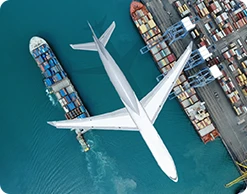
GUARANTEE TRUSTED
Trusted by
Worldwide Clients
-
Ship With Us
-
with 100% satisfaction
No products in the cart.


Freight refers to the transportation of goods in bulk by truck, train, ship, or aircraft. It can also mean the goods themselves that are being transported1. Additionally, freight is the charge paid for this transport service1. As a verb, to freight means to transport goods in bulk by these methods.
Freight pricing is determined by a combination of factors that include the type of freight, mode of transport, weight and size of the shipment, and the distance to the delivery destination
Sea freight services offer several benefits, making them a popular choice for international shipping. Here are some of the key advantages:Economical: Sea freight is often the most cost-effective option for transporting goods over long distances. It is generally four to six times less expensive than air freight. Efficiency: Sea freight can accommodate various shipment sizes. Smaller shipments can be grouped in containers (LCL), while larger shipments can fill one or more containers (FCL), providing flexibility and cost-sharing opportunities. High Volume Capacity: Ships are designed to carry large volumes of cargo, making sea freight ideal for transporting high volumes of goods or raw materials. Oversized Cargo: Sea freight is capable of handling oversized, heavy, or bulky cargo that might be too large or heavy for other modes of transport. Safety: The shipping industry has stringent regulations for handling hazardous materials and dangerous cargo, ensuring the safety of the vessel, crew, cargo, and environment. Environmental Friendliness: Shipping has a lower carbon footprint compared to air and other transportation modes. As technology advances, emissions continue to decrease, making it a more sustainable option
To secure the value of your shipments during transport, we offer you the possibility to insure your goods. This Cargo Insurance will cover for the lesser of the actual repair or replacement costs, up to the insured value, in the event of any physical loss or damage to the shipment. Actual and verifiable Receipts/Invoices and shipment copies shall be provided to evaluate the value of contents, thereof, if requested by Shipwise. Customer will inform Shipwise of any special routing or other conditions for Controlled Goods that apply prior to shipment.
Securing cargo during sea freight transport is crucial for the safety of the shipment, the vessel, and the crew. Here are some standard methods used to secure cargo inside a sea container:Shoring: This involves using bars, struts, and spars in voids to keep cargo pressed against walls or other secured items1. Lashing: Cargo is secured using ropes, chains, straps, wires, or nets attached to anchoring points that provide tension against the cargo2. Lashings and Tie-Downs: These are situated to apply tension in the direction of the surface to which the equipment is secured, which may be a wall as well as a cargo bed or floor. Types of lashings and tie-downs include webbed material, chains, straps, ropes, and cords

Ship With Us
with 100% satisfaction
EXPLORE
INFORMATION